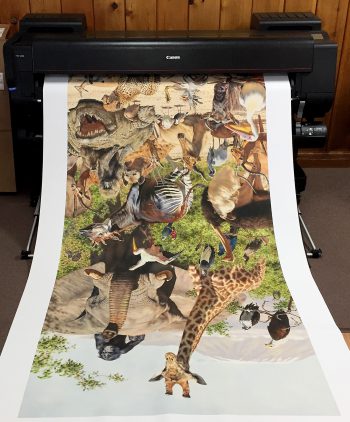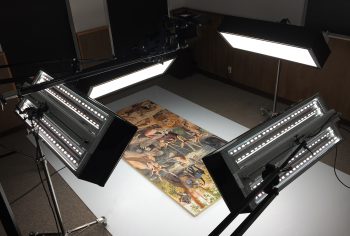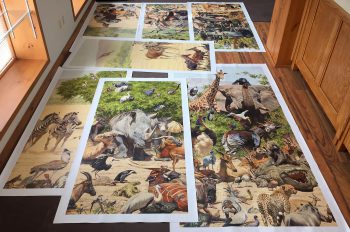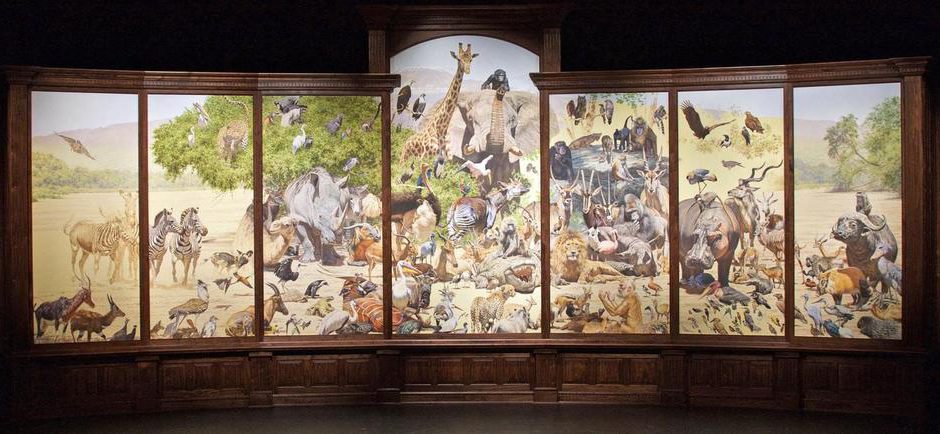Last fall, Christopher Glassman, general partner at Casual Graphics in Hays, Kan., got a call to reproduce an enormous painting by Brian Jarvi titled “African Menagerie.” The painting, which captures 210 species living in Africa now, was 17 years in the making. It’s been part of a traveling exhibit and Jarvi wanted a more manageable version for smaller venues, as well as prints for reproductions, books and other uses that might come up.
“Chris is the consummate professional,” Jarvi says. “We were very fortunate to have somebody right there who was so skilled. The reproduction is probably superior to anything we’ve had done prior, and with that said, the Menagerie was probably the greatest challenge, as well.”
We caught up with Glassman to ask him about the project and how they pulled it off:
Q. How did you get involved with Brian’s project?

In late October, I received a call from Gregory Walters, Exhibits Manager at Fort Hays State University’s Sternberg Museum of Natural History inquiring about the possibility of capturing the painting that they presently were exhibiting. Brian needed it commercially captured for books being developed and for possible reproduction at full scale. It’s a large piece consisting of seven panels with the largest measuring 5-foot-by-10-foot. I love challenges and this would definitely fit into that category, so I was excited for the opportunity.
Q. What all did the project entail for Casual Graphics?
The project required our capture studio, print and finishing services. After the prints were completed, we mailed them to Brian for final stretching and mounting for display. Due to the size, mailing the prints in a tube was more economical, and then he could have a local framer stretch them.
Q. How did you capture the images for printing?
Each panel was removed on location at FHSU Sternberg Museum of Natural History from the cabinet that was built to house them, and then brought one by one to our capture studio. I scanned the images using a Phase One Power Phase FX II scanning back. After years of experimenting, we decided to make the investment into the Power Phase. Prior to this acquisition, we had scanned artwork with a Epson 12-inch-by-18-inch flatbed in pieces and stitched them, which yielded good results, but the time it took was not cost-effective.

Believe it or not, I’ve scanned 4-foot-by-8-foot pieces on the Epson, and you would never know it. Process was and still is a big player with any project to attain good results. Point-and-shoot cameras have come a long way and do a wonderful job on small pieces, but the Power Phase, even though it’s an older technology, continues to produce and hold its own even today with emphasis on larger pieces. It took approximately 110 hours to complete the project.
Q. Why did you choose LexJet Sunset by Fredrix Matte Canvas?
I reached out to Dave Grotkiewicz, our sales representative at LexJet, for some advice and feedback on our project before making the final decision. Initially, we discussed Sunset Reserve Bright Matte Canvas but the Wilhelm Archival Quality Standard outweighed all other factors. The archival qualities, coupled with one of the brightest white points for a natural OBA-free canvas, proved to be a good match up for Brian’s needs.
Q. Did you coat the canvas?
Coating was an important step in the process, and we chose LexJet’s Sunset Satin Coating, which has the perfect sheen and UV inhibitors the project demanded. Application was done using a HPLV paint spray gun. We honestly use this coating on most all of our canvas prints.
Q. Which printer did you use for this project?
Though latex is becoming more popular for its print-and-go characteristics, we chose our newly purchased Canon imagePROGRAF PRO-6000 due to its large color gamut and LUCIA PRO inks, not to mention image quality. The Canon line of iPF printer series has served us well since out first purchase in 2007. I believe that we were one of the first Canon imagePROGRAF PRO-6000 purchasers from LexJet.

Q. Where will the final prints be displayed?
I believe that Brian is using them for art shows and resale opportunities. Also, some potential tour venues might be too small to host the original presentation, which is roughly 14-feet-by-32-feet, so a reduced reproduction would fulfill those needs. We’re in the process of making smaller prints for our own showroom and to address the interest from local patrons wanting to purchase and also help educate on the challenges in Africa.
Q. What do you think people will come away with once they hear Brian’s story and see the prints?
That would depend on your interests. If it’s the plight of the animals and plants of Africa, then Brian’s project surely puts a spotlight on it. I learned quite a few things from Brian as we discussed the evolution of this project and the trips he took to Africa over the course of 25 years. One being the indigenous people continue to hunt and eat the animals that I thought were mainly being hunted for profit or sport. How can you blame a person that is hungry to stop eating what is and has been one of their primary food sources for millennia? Hopefully, the collective powers will be wise enough to address all hunger issues and protect our planet with its many rich resources for future generations to come.

Now, if it’s the process of reproducing a work like Brian’s, then maybe it’s just the simple fact that it is possible. You don’t have to be the biggest production house in the world with a million dollars of equipment. Nor do you have to be located in a metropolitan area. Opportunity will find you if your focus is on superior quality and service coupled with the gained knowledge and experience from every project.
I suggest to reach out like I did and still do, ask questions about something you don’t fully understand. Read, read, read — this is something that is your biggest tool to learning anything from the ground up, and I believe is not appreciated these days due to YouTube video training and quick opinions on blogs, which can help, but, many times, I found is filled with what I call half-baked knowledge. So vet your sources and make sure you are being educated with good information, for which LexJet is a great resource.
Q. How did Casual Graphics get started?
Casual Graphics was created by me and my brother, Mark Glassman, in 1991. We opened Jan. 1, 1992 in Hays, Kansas. We grew up in Hays and graduated from Fort Hays State University (FHSU), a local university. A vision of the digital revolution sparked us and that, in itself, was enough reason to attempt to ride the wave of designing and printing technologies to this day.


Thank You Shellie for interview and story!
Thanks for sharing this inspiring story with us, Chris!
Very nice story and writing. I appreciate knowing of other artists (painters, photographers) who try to make a difference by communicating with quality art, and its reproduction capabilities. I wish that original art could be affordable to more people, but illustrated by such cases as this, the digital answer is definitely the only way to make it so.
Thanks, Philippe! Glad you enjoyed Chris and Brian’s story!
We have had art scanned snd prints created by Chris and his team. They do an amazing job. They are able to capture color perfectly, and satisfying my perfectionist artist husband is no easy feat!!